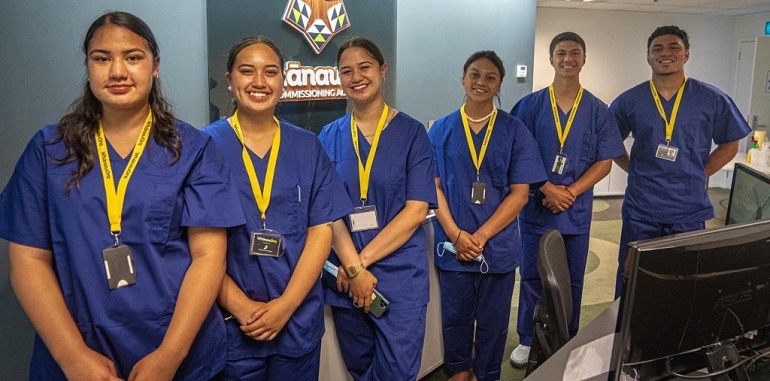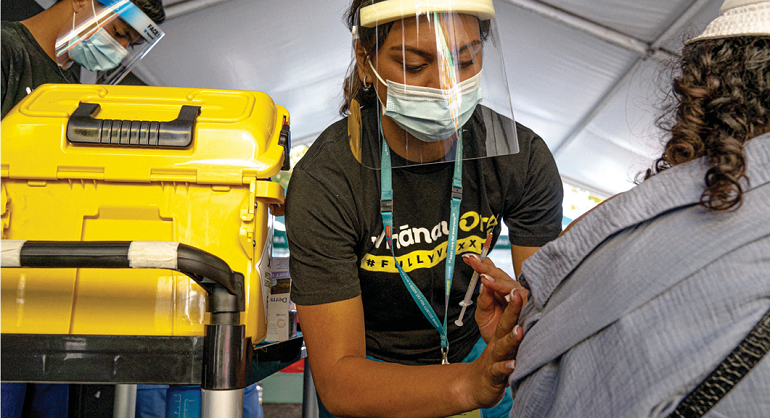Community health, education & social services (featuring in-depth work on health)
Tāmaki Makaurau requires more health workers to meet immediate and future needs. Action is required to fast-track and significantly increase those training in the sector, but it cannot be done under business-as-usual practices.
On this page
The pandemic has also increased alcohol and drug consumption in response to anxiety and stress. Some of these impacts are likely to be lower life expediency, higher health costs, lower education outcomes, and reduced employability and productivity. There is a long backlog of patients with other health conditions not seen or screened over the past 2 years due to COVID-19, resulting in more chronic conditions and greater need of interventions. Free riding on the training efforts of other countries may become difficult as competition for skilled labour becomes greater, and Aotearoa New Zealand is increasingly unable to compete on wage rates and other conditions.
There is no doubt that the country has a health workforce crisis. Action to retain and train the COVID-19 surge workforce and fast-track migrant and local students at this time of acute workforce shortages is required. Business-as-usual and training caps must be set aside. In Tāmaki Makaurau, cross-table talks amongst Health New Zealand, the Māori Health Authority and local education providers are underway.
Toitū te Waiora
In 2021, Toitū te Waiora (community, health, education, and social services) Workforce Development Council (WDC) represented 168,815 filled jobs with a contribution of $12,976 million to GDP. The largest, and growing, occupation is primary school teachers (8% of the total WDC workforce), with education workforce development struggling to keep pace with the region’s youthful natural population growth need. The workforce comprises 7.1% Māori employees (Infometrics 2022). Some of the health workforce is represented by Toitū te Waiora including care services, youth services, disability services, education and educational support services, funeral services, mental health and addictions services, health services, public order safety, regulatory services, skin and nail therapy services, social services, and urban pest control.
Tāmaki Makaurau has attracted a large migrant labour force in the health sector. Before borders closed, migrants made up 15% of the health workforce, compared with 9% in the rest of Aotearoa New Zealand. The COVID-19 response has further compounded these pressures and risks for the health sector's workforce. These pressures have built up not just in response to COVID-19 and the vaccination services, but also due to workforce challenges across the sector and population, along with deteriorating mental health of the health workforce, already suffering with significantly stretched services.
He Ara Oranga Mental Health and Addiction Report [5.94 MB](external link) — Government inquiry into Mental Health and Addiction
Aotearoa New Zealand currently relies heavily on overseas-qualified health practitioners, particularly doctors (40% are overseas trained; the second highest% in the OECD) and nurses (30% are overseas qualified; the highest in the OECD). According to the World Health Organisation, by 2035 there will be a projected shortage of 12.9 million healthcare professionals globally. For pre-pandemic Tāmaki Makaurau, the health sector was already experiencing increasing demand due to an ageing population living longer, as well as supply-side pressures caused by an ageing supply of healthcare professionals.
82,151 filled jobs in health sector
11,188 needed for new jobs
Health sector labour market and workforce insights
- Tāmaki Makaurau has the largest health workforce in Aotearoa New Zealand and is the third-largest employing sector in the city with 82,151 filled jobs (March 2021).
- The sector employs the most significant proportion of women and has an older workforce. The Tāmaki Makaurau workforce is less likely to be Māori or Pacific and more likely to be European/Pākehā and Asian.
- Nurses and carers are the largest occupations as a proportion of the workforce.
- There is minimal capacity to utilise the existing workforce as 60% are already working more than 30 hours per week.
- Since the turn of the century, the health workforce has doubled, and in the past 5 years, it has increased by 13%; a few percentage points more than the general employment growth in Tāmaki Makaurau.
- 11,188 people are needed for new jobs and to replace those retiring or leaving in the next 5 years.
- The fastest growth is in aged care residential services, with over 20% in the next 5 years. A total of 7,302 people are needed for new jobs or to replace those retiring or leaving.
- The most significant demand is for Registered Nurses, expected to increase by 3.4% a year. Roles in demand are across all nursing disciplines but mostly in medical nursing.
- Registered Nurses in an aged care setting, Nurse Practitioners and Nurse Researchers have the fastest-growing number of job openings.
- There are job openings for GPs and Registered Medical Officers. However, job openings are less than 0.5% over the next 5 years. Most job openings are replacement roles due to retirement or those leaving the profession.
- The primary driver for employment growth is population growth and the population's rate of ageing
- There is a differing geographical labour market with a more localised labour market for health care assistants and carer roles and an international market for specialised health roles, i.e., nurses and medical specialists (Organisation for Economic Cooperation and Development, 2019. OECD Employment Outlook 2019).
OCED Employment Outlook 2019(external link) — OECD iLibrary

Tāmaki Makaurau rangatahi aged 16 -18 yrs, who supported the COVID-19 response at Whānau Waipareira.
Training also as vaccinators and now New Zealand's youngest lay vaccinators.
Photo: Te Whānau O Waipareirā
Workforce planning challenges
A longer-term focus on increasing numbers in training and completing training requires continued collaboration. Within the sector, some extensive work is being undertaken such as the Nursing Pre-registration Pipeline Working Group; a partnership between DHBs, tertiary education providers, Ministry of Health, Nurse Education in the Tertiary Sector (NETS), Nurses Organisation (NZNO) and the aged care sector. The initiatives it is undertaking include working with the education providers to identify why students are not completing their studies. There are several barriers to substantially increase the training of nurses and the RSLG will address these next, but these will take 3 to 4 years to work their way through the system.
Nursing Workforce Resources(external link) — TAS | Harnessing smart thinking on health for New Zealand
However, there are some immediate steps that could be taken to increase the nursing workforce:
Bring back nurses who have left the profession into the profession
The barriers to this are re-registration, re-training that may be needed in order to re-register, the negativity of an overworked profession and the (current) inadequate salary levels in the profession. There needs to be much more flexibility in the approach of the Nursing Council and other regulatory bodies to re-training and re-registration. Further, there seems to be a lack of dialogue between the regulatory, employing and vocational education bodies to ensure the required re-training is immediately available.
Increase the numbers of migrant nurses to help fill the current gap
There are 4 aspects to this, each with their own barriers. First, airfares and sign-on bonuses could be offered to encourage Aotearoa New Zealand nurses to return from overseas. Second, there are many immigration rules and decisions that are still forcing migrant nurses in Aotearoa New Zealand to leave the country. These must be urgently resolved. Third, there needs to be alignment between the registration, employing, vocational education bodies and NZNO to ensure that the most efficient additional training or assessment is given to migrant nurses already in or entering Aotearoa New Zealand to ensure that they can practice as soon as possible. There seems to be a lack of any programme to proactively bring migrant nurses with non-recognised qualifications into a system which will recognise their prior learning and tailor courses to the gaps in knowledge and competency that the overseas trained nurses may have. Fourthly, Immigration NZ and nursing employers must be aligned to bring in migrant nurses and priority must be given to nursing applications by Immigration NZ.
“Free up” of nursing time by more use being made of allied (non-registered) health professionals
A good example of this is the training of (non-nurse) vaccinators and Polymerase Chain Reaction (PCR) testers during the COVID-19 pandemic. This led to fewer nurses being required and those nurses taking on a more supervisory and monitoring function, which worked well at the Waipareira Trust and released nurses for other duties. Regulation barriers must be reduced to enable more of this to happen in other parts of the health system.
Health sector actions
Agreed during actions workshop with RSLG members and follow up discussions with key sector and industry stakeholders including WDC consultations where relevant.
- The RSLG advocates removing barriers and fast-tracking local and migrant training.
- The RSLG supports immediate actions to increase the broader health workforce.
- The RSLG promotes utilisation of the comprehensive data and forecasts existing in the sector to validate investment in workforce development.
- The RSLG will support more joined up pathways for career progression within professional categories, including to address disjointed journeys from vocational education and training to tertiary training that the Reform of Vocational Education has not addressed.
“It’s just like the way that we work together. It’s like a whole whānau, you know? And it’s all positive and like who wouldn’t want to work in a positive environment every day?”
Kaimahi
Te Pae Herenga o Tāmaki – Covid-19 Response Workforce Development Case Study
This case study about Te Pae Herenga o Tāmaki (Te Pae Herenga) – a collective of Whānau Ora providers in Tāmaki Makaurau – highlights how a coordinated ‘by Māori for Māori’ approach was able to quickly mobilise and upscale a COVID-19 workforce. Te Pae Herenga was created on the foundations of kaupapa (purpose) and tikanga (guidelines) Māori, with pre-existing inter-partner and trusted community connections already in place and a long track record of high-quality service delivery in their communities. This helped them quickly move resources and mobilise a Māori workforce to deliver much needed services to whānau. The key success factors identified for the Te Pae Herenga COVID-19 response was the compelling vision and Kaupapa, Tikanga, Community-based solutions, leadership and advocacy, rapid Innovation, goodwill.
How we respond to crises can define us and alter the course of our life journey. COVID-19 is a crisis. It has disrupted the lives of whānau, changed the way we work and required new rules of engagement. In Tāmaki Makaurau, the crisis has hit hardest. Rangatahi experienced a dramatic shift in their realities. How Rangatahi were supported to respond to this challenge is an illustration of Tāmaki 10,000 in action.
When our young people are supported to learn in an environment that affirms them as Māori, it provides them with practical skills and work readiness knowledge, they are able to dream bigger, better and brighter.
When our young people are supported to learn in an environment that affirms them as Māori, it provides them with practical skills and work readiness knowledge, they are able to dream bigger, better and brighter.
“Working within your community is a different type of fun and heartfelt. It feels good to know you contributed to high vaccination rates in your community.”
“I spent my first pay on my family. It was good to be able to do this.”
“I was like still trying to decide if I want to go into the law field or the medical field. But doing this work, and actually enjoying science in school as well, it made me lean more towards the science field. So it definitely has had an impact on what I want to do with my career.”
Voices of the Te Pae Herenga rangatahi kaimahi/volunteers, some of whom become accredited as the youngest vaccinators in Aotearoa.

Photo: Te Whānau O Waipareirā

